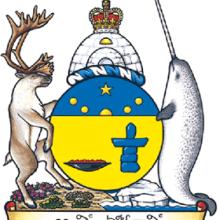
Unreliable Geographies by Aeneas McHaar
No. 10: Broughton Island, Nunavut, Canada
67º 33’ N, 64º 01’ W
Broughton Island lies in Canada’s Davis Strait, 60 miles north of the Arctic Circle. Its indigenous people have traded with Europeans since the early 17th century but their land did not get its present name until 1818 when the arctic explorer Captain John Ross named it after his friend Commodore William Broughton (1762–1821). (We have briefly encountered William Broughton at an earlier stage of his career off the coast of New South Wales [Unreliable Geography no. 3].)
Since November 1998 its native residents have been officially known as Qikiqtarjuaq, which may sound like teeth chattering with cold but in the Inuit tongue means ‘from the Big Island’. Broughton Island, however, measures only 9 miles by 12 miles, and is dwarfed by its neighbour Baffin Island and some of the icebergs floating past on summer holidays from Greenland. Evidently, Edinburgh’s is not the only small community called Broughton occasionally to get things out of proportion.[img_assist|nid=964|title=|desc=|link=node|align=right|width=160|height=200]
A few facts and figures. The population is in decline. Only 473 people lived here in 2006 compared to 519 five years earlier. Occupying about 136 private dwellings, all but 30 are Inuit. Their median age is 26. For most people, old age isn’t an option. This is a hard, hard environment in which to sustain life. In fact, Qikiqtarjuaq makes Beaver Bank (Nova Scotia) look like Hawaii. In February, it can reach -18.4º F (-28º C) and in July has never been recorded above 42º F (6º C). Even Arbroath FC supporters experience difficulties at such temperatures.
It is in the summer that the sea ice breaks up, and consequently when the sale or transport of alcohol is forbidden. This is for safety reasons, but whether it is for the safety of drunks or the safety of precious reserves of booze is not clear. For obvious reasons, global warming features heavily in locals’ thinking, and its consequences have begun to put them on a collision course with the Canadian government.[img_assist|nid=965|title=|desc=|link=node|align=right|width=200|height=145]
Global warming affects polar bears, and Canadian wildlife officials reckon the creatures’ local population has dropped from 2,100 to 1,500 in the last 10 years. But locals reckon the population has risen. They deplore the small role given to Inuit traditional knowledge in polar bear research, which, they say, has worked well for them over many generations. They criticise infrequent and poorly managed surveys, and point to the bears ‘marauding meat caches, wrecking cabins, eating seals and walrus pups, and endangering people in the communities’.
Government officials suspect fewer polar bears may be concentrating on fewer sources of easy food. They want to cut the 105 bears Inuits legally hunt each year. Inuits by contrast slam the ‘southern media’ for making bears a symbol of climate change: ‘Those are our bears and we can hunt them the way we want.’ At a recent meeting – according to a local newspaper reporter who, after 9 hours, lost the will to live and went to bed – Koalie Kooneeliusie voiced hunters’ frustration: ‘Inuit are very patient, but now that patience is wearing thin.’[img_assist|nid=966|title=|desc=|link=node|align=right|width=200|height=185]
The Inuit may be right or they may be wrong, but it would be mistaken to think they make sense just because they’re indigenous folk who can’t be blamed for the greenhouse gases at the root of the problem. Ever since they began advertising ice creams and Findus fish fingers on TV, we’ve come to think of them as cheerful eccentrics in parkas who stolidly inhabit our freezers. In fact they are potentially every bit as short-sighted and venal as we are. In recent years they have begun harvesting mini-geoducks (mya clams) for the Asian market, and – given the profit margins – probably won’t stop until there are none left; after all, in a land where a packet of cigarettes costs $16, and 85% of Inuit aged over 15 smoke daily, they obviously need the money.[img_assist|nid=967|title=|desc=|link=node|align=right|width=155|height=200]
Oh, don’t give me your bleeding-heart, aboriginal get-out-of-jail-free-card nonsense! A thousand years ago the Inuits’ ancestors – the Thule culture – took advantage of a warm spell to migrate from northern Alaska and ethnically cleanse the 3,000-year-old ‘Dorset’ culture they found in their path. We all have the capacity to be as bad and as good and as wrongheaded as each other.
Perhaps it’s because this community is artificial (it only coalesced in the late 1950s around a NATO early-warning radar base); perhaps it’s because the Hudson Bay Company set up shop in 1960; perhaps it’s because Anglicans, Mounties, Evangelists, satellite TV engineers and wilderness tourists with hotel expectations are all – year upon year – salami-slicing whatever quality it was that maintained a fragile equilibrium between Man and Environment; but the pristine North is disintegrating.
Bears are desperate. People are worried. Each year, locals organise a Suicide Prevention Walk, travelling 37 miles across tundra to ‘promote hope among the community’. What’s going to happen? Nobody knows. It’s a shared problem. The number of icebergs is growing as the ice sheets shrink. Old certainties – such as normality, and tradition – are things of the past.